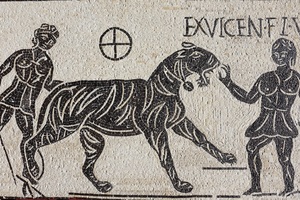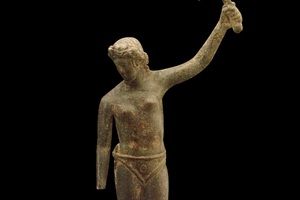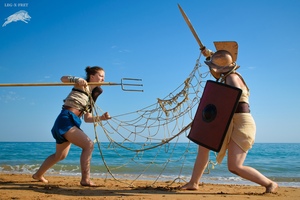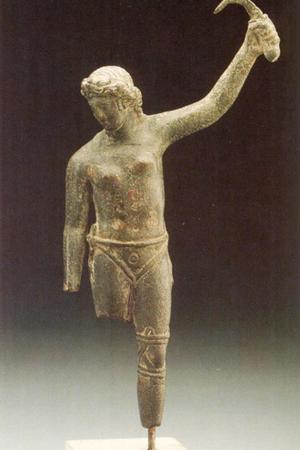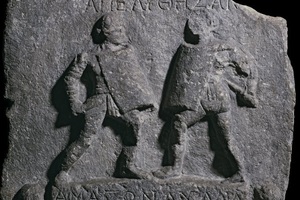Gladiatrix
Gladiatrix (Lat. gladiatrix) - is the term used for women who performed as gladiators in ancient Rome. It should be noted that the Romans did not have a specific word for a female gladiator. Gladiatrix, gladiatrixa, or gladiatrix are modern terms that refer to a female gladiator. The equipment of gladiatrices was identical to that of male gladiators and depended on the type of gladiator they belonged to.
History of female gladiatorial combat:
- The exact time of the appearance of gladiatrices is unknown, but researchers believe they emerged in the 1st century BCE.
- In 11 CE, a senatorial decree (senatus consultum) was issued, prohibiting freeborn women under the age of twenty and men under the age of twenty-five from appearing on stage or in the arena.
- In 19 CE, a new senatorial decree was passed, establishing additional penalties for men and women from the senatorial or equestrian classes who would participate in stage performances or arena battles. It was also prohibited to recruit daughters, granddaughters, and great-granddaughters of senators and equestrians who had not reached the age of twenty into the ranks of gladiators. This law indicates the increasing popularity of female combat, not only among enslaved women, who were mostly coerced into such activities, but also among free women from noble families.
- In 63 CE, Emperor Nero issued a decree officially allowing free women to participate in gladiatorial tournaments. In 66 CE, Nero organized an extravagant spectacle in the city of Puteoli in honor of the Armenian king Tiridates I, which included Ethiopians, including women. It is believed that the peak of popularity for female combat occurred during the reign of Nero (54-68 CE) and Domitian (81-96 CE). It is mentioned that "there were few female gladiators, and they often performed as pugniarii, entertaining the audience rather than as gladiators dealing death."
- In 200 CE, by the decree of Emperor Septimius Severus, the participation of women in gladiatorial combat was completely prohibited.
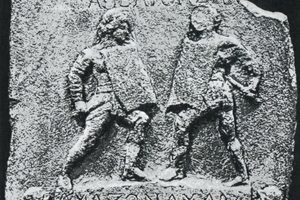 A duel between two gladiatrix players-Amazon and Achillia. British Museum. Inv. no. 1847.0424.19. 1-2 century AD
A duel between two gladiatrix players-Amazon and Achillia. British Museum. Inv. no. 1847.0424.19. 1-2 century ADSources
In addition to written references to gladiatrices in the legislative base of ancient Rome, there are also literary sources:
- In "Satyricon" by Petronius, there is a mention of a certain Titus who "has several boys, a woman essedarius, and Glycon the treasurer..."
- "Annals" by Tacitus describes events from 63-64 CE: "This year was also marked by the organization of gladiatorial games, no less magnificent than the previous ones; but at the same time, an even greater number of noblewomen and senators sullied themselves by stepping into the arena."
- Dio Cassius, in one of the books of "Roman History," reports on a festival organized by Emperor Nero in honor of his mother. At this festival, both men and women participated not only in equestrian competitions but also performed, with the permission of the Senate, in orchestras, circuses, and were involved in animal hunts and gladiatorial combat. In another book of "Roman History," Cassius speaks of a grand battle organized during the reign of Titus, involving gladiators and animals, in which women also participated, without holding a special position in society.
- Suetonius, in "The Lives of the Twelve Caesars," provides information about the reign of Domitian and writes:
"He staged hunts and gladiatorial games even at night by torchlight, and both men and women participated in them." There are mentions of gladiatrices in Martial's "Book of Spectacles": "About the lion's defeat in the vast valley of Nemea, About Hercules' ancient exploit, the rumor sang. Let the ancient myth be silent: such a miracle, Caesar, you have allowed to be performed by a woman's hand..."
Female gladiators are ridiculed in Juvenal's 6th satire: "She should take part in games under the trumpets at Flora's festival; Instead, does she not strive for the real arena? Could there be any shame in such a woman wearing a helmet, Loving strength, despising her gender? But she did not want To become a man: for us, pleasures are lacking. Here is your honor when a young wife Sells her knee guard, starting other battles! These same women also feel hot in a thin cloak..."
- Statius mentions gladiatrices in "Silvae": "Amidst these cheers and unheard-of amusements, the weak and unfit for weapons gender shames itself, giving battles meant for men."
- Many data has been obtained through archaeological excavations. The study of ancient inscriptions indicates the presence of women among gladiators. In particular, in the territory of Roman Britain, which was part of the Roman Empire, two burials were discovered that could belong to female gladiators:
- The burial of a woman approximately in her twenties who died in the 1st century CE. It was discovered in 1996 in the Southwark area of London (the discovery was officially announced in 2000). The woman became known as the "Great Dover Street Woman." In this burial, two oil lamps were found, one of which depicts a fallen gladiator and the other depicts the Egyptian god Anubis, who was associated with gladiatorial contests as the guide of human souls to the realm of the dead. Many scholars lean towards the belief that the buried woman was a gladiator.
- The burial of a woman discovered in Herefordshire in July 2010. Archaeologists were able to determine that the woman had a robust physique and well-developed musculature during her lifetime. Although no weapons or other items associated with the life of gladiators were found in the burial, many researchers, based on the burial's location and other characteristics, believe that the woman could have been a gladiator.
- The British Museum houses a marble plaque dating back to the 1st or 2nd century CE, which was found near the Turkish city of Bodrum, located on the site of the ancient city of Halicarnassus. The plaque depicts two women engaged in combat, wearing the typical equipment of male gladiators. The names of the participants in the duel, Amazon and Achilia, are written in Greek on the plaque (presumably, these were their nicknames used in the arena).
- There are many urban inscriptions mentioning female gladiators. For example, an inscription from Ostia dedicated to a local magistrate named Hostilianus reads, "Hostilianus was the first under whom the city opened women's fights" (original: QUI PRIMUS OM[NI]UM AB URBE CONDITA LUDUS CUM [--] OR ET MULIERES [A]D FERRUM DEDIT). It is dated to the 3rd century CE, indicating that the inscription testifies to the violation of the decree of 200 CE that prohibited women from participating in combat.
- In Lancaster, a ceramic shard with a Latin inscription was found, which reads VERECVNDA LVDIA LVCIUS GLADIATOR, possibly translated as indicating that this item belonged to a female gladiator named Verecunda.
- An inscription found in one of the Roman gladiator schools mentions a certain Valeria Iucunda, who was apparently a student of that school and lived for 17 years and 9 months.
Related topics
Gladiator, Equites, Bestiarius, Murmillon, Thraex, Amazons
Literature

 Gallery
Gallery






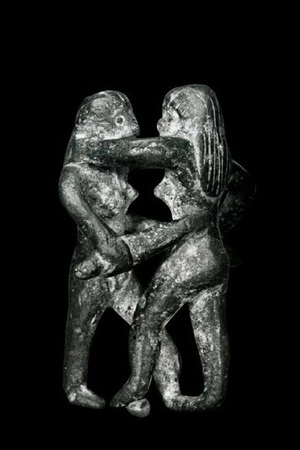 Statuette with two wrestling gladiators. Found during excavations in Izmir. The British Museum. Late 1st century BC
Statuette with two wrestling gladiators. Found during excavations in Izmir. The British Museum. Late 1st century BC 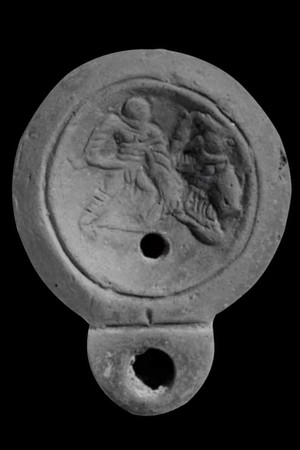 An oil lamp depicting a gladiator fight. The fighter on the right is a woman. Found in the sanctuary of Demeter in Cnidos. The British Museum. 2nd century AD
An oil lamp depicting a gladiator fight. The fighter on the right is a woman. Found in the sanctuary of Demeter in Cnidos. The British Museum. 2nd century AD 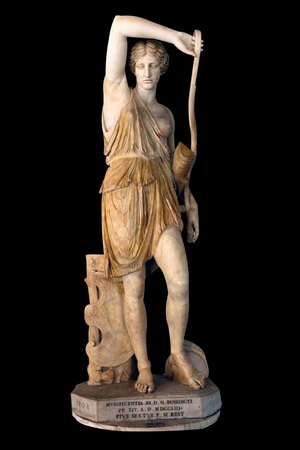 Statue of the Amazon. Roman copy from the original Greek. Capitoline Museum, Italy. The original is from the 5th century BC.
Statue of the Amazon. Roman copy from the original Greek. Capitoline Museum, Italy. The original is from the 5th century BC.